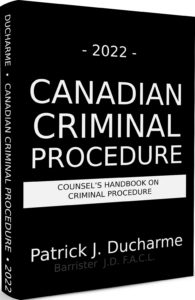 |
| Patrick Ducharme |
It is the Crown’s responsibility to prove beyond a reasonable doubt that the person complaining of having been assaulted did not consent to the conduct that forms the basis of the alleged assault. But that requirement of proof beyond a reasonable doubt is obviously aided significantly by sections 265 and 273.1. The Crown’s requirement to prove any form of assault beyond a reasonable doubt is also made easier by the judgment of Jobidon in the Supreme Court of Canada.
In R. v. Jobidon1 the Supreme Court of Canada was dealing with the defence of consent in the context of a fist fight between two men. The accused was charged with manslaughter because of a fist fight.
The fight started in a bar. The deceased victim appeared to be winning the fight in the bar, but he and the accused were asked to leave the bar by the owner. They did so. The accused waited for his opponent in the parking lot. When his opponent came out of the bar people gathered around them to watch the continuation of the fight.
As both men stood facing each other the accused was the first to strike; he did so with his fist and with great force. His opponent was knocked backwards onto the hood of a car. As he lay prone on the hood of the car the accused attacked fiercely striking him several times in the head. Eventually, after many blows to the head, the victim’s body slid lifelessly off the hood of the car and onto the pavement. He was rushed to the hospital where he died.
This type of circumstance probably happens hundreds of times a year in Canada. Fortunately, most fist fights do not end in death to one of the combatants.
This case formed the backdrop to a new principle of law for “lawful consent” in Canada. While acknowledging consent as a valid defence in Canada the court found that there are limits on consent recognized by English and Canadian courts. In these circumstances both combatants consented to a fist fight. But the court determined that consent had to have reasonable limits placed upon what would otherwise be a valid consent.
The court found that it is not in the public interest that adults should willingly cause harm to one another without good reason. Further, there is no social value in fist fights or street brawls. These activities, the court wrote, often lead to serious breaches of the public peace.
The court found that the offence of assault referred to in section 265 of the Criminal Code demands certain reasonable limitations. In these circumstances the court found that the victim’s consent to a fist fight did not preclude the commission of the offence of assault. The limitation demanded by section 265 vitiates consent between adults who intentionally apply force that causes serious injury or non-trivial bodily harm. The court concluded that section 265(3) negated the applicability of common law rules that describe one’s consent to this type of assault where serious bodily harm is caused. It is fair to say that our courts have placed a significant limit on the concept of consent.
Apparently, one can consent to a fight, but not a fight that ends in serious bodily harm. Serious bodily harm vitiates any actual or perceived consent.
The court found that given the danger inherent in the violent activity of a fist fight, the scope of the consent requires scrutiny and lawful limitations. The accused, by continuing to pummel the victim after he knew the victim was unconscious, knowingly acted beyond the ambit of the victim’s consent.
In summary, in Canada, one cannot consent to serious bodily injury. The nature and quality of the act and the fact that it places the other party at risk of harm or death vitiates any actual or perceived consent.
This principle of limiting the ambit of consent fits with other stated limits on consent in the field of sexual activity. For example, a victim of sexual activity does not consent if the victim believes reasonably that the withdrawal of consent will cause her to suffer physical violence. The approach therefore is subjective. The plausibility of the alleged knowledge or fear of the victim, or any overt expressions of that fear are now relevant to assessing whether the victim has chosen to participate. If there is any ambiguous conduct or submission by the victim, it may be viewed as evidence of the absence of consent.
Consent requires a conscious, operating mind, capable of granting, revoking, or withholding consent to each act (sexual or assaultive). It is not enough for the accused to “believe” that another party is consenting. The accused is required to take active steps to determine consent. He or she must take reasonable steps to ascertain consent and to believe that the other party has communicated that consent to engage in potentially assaultive behaviour or sexual activity.
There can be no valid consent if the opponent is defenseless or unconscious.

The above is the an excerpt of Patrick J Ducharme's book, Canadian Criminal Procedure, available at Amazon or in bulk through MedicaLegal Publishing along with Criminal Trial Strategies.
Subscribe to Patrick Ducharme's Youtube Channel
